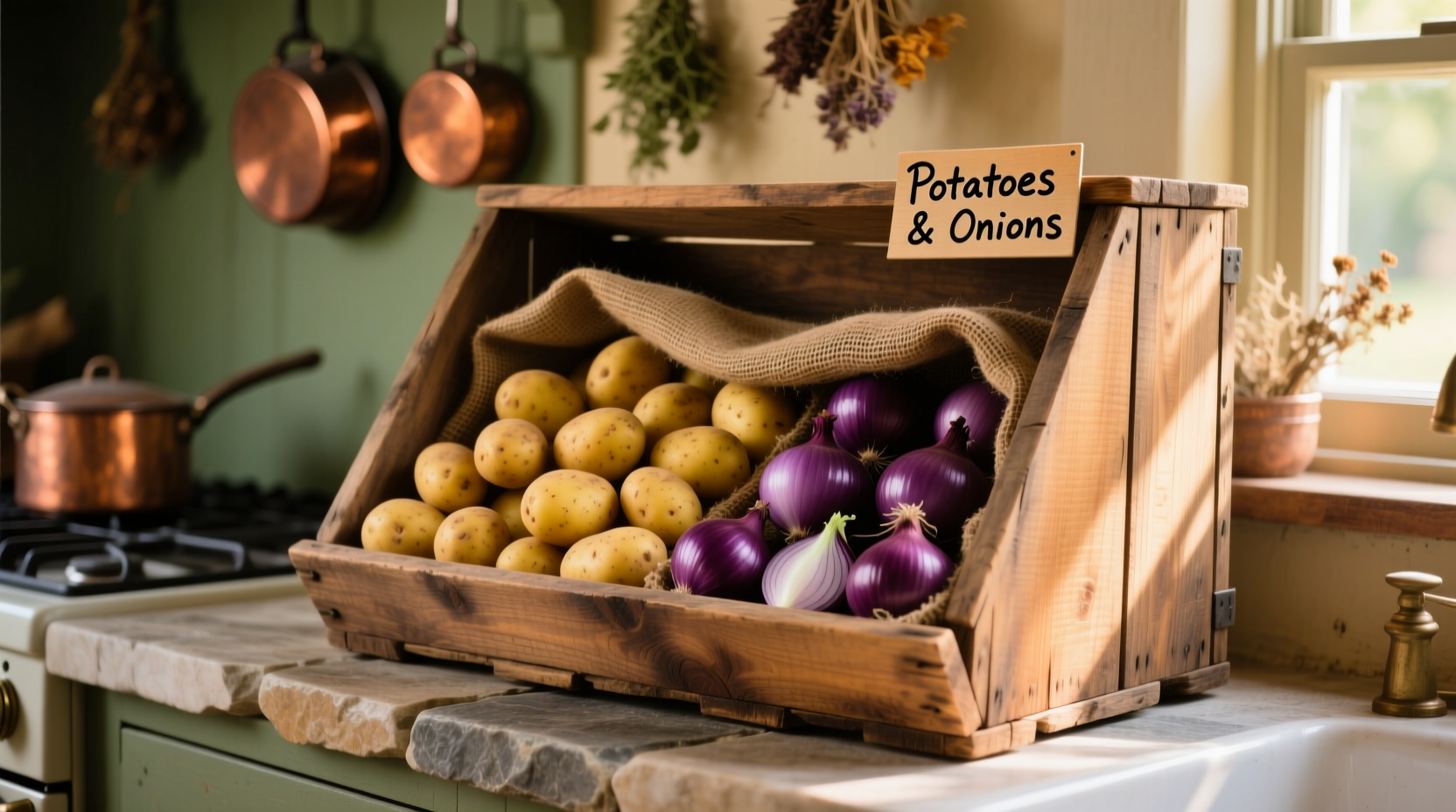Why Your Potatoes and Onions Keep Spoiling
Most households lose 20-30% of their root vegetable harvest to improper storage. The USDA estimates American families waste $1,500 annually on spoiled produce. Understanding the biological needs of these vegetables prevents this costly mistake. Potatoes and onions have fundamentally different storage requirements that conflict when stored together.

Storage Requirements Compared: Science-Backed Guidelines
| Factor | Potatoes | Onions | Why It Matters |
|---|---|---|---|
| Temperature | 45-50°F (7-10°C) | 32-45°F (0-7°C) | Colder temps slow sprouting in onions but cause potatoes to convert starch to sugar |
| Humidity | 90-95% | 65-70% | High humidity prevents potato shriveling; lower humidity prevents onion mold |
| Ventilation | Moderate airflow | High airflow | Onions need constant air movement to prevent moisture buildup |
| Light Exposure | Total darkness | Darkness | Light causes potatoes to produce toxic solanine and turn green |
This comparison reflects guidelines from the USDA Agricultural Research Service on post-harvest handling. Storing these vegetables together creates a lose-lose situation where neither maintains optimal condition.
Your Storage Timeline: What Happens When Conditions Aren't Perfect
Understanding the spoilage timeline helps identify storage problems early:
- Week 1-2: Ideal conditions show no visible changes. Suboptimal conditions begin moisture loss (onions) or slight softening (potatoes)
- Week 3-4: Onions in high humidity develop mold spots; potatoes in light start greening
- Week 5-8: Onions sprout when near potatoes; potatoes develop deep sprouts in warm conditions
- Month 3: Significant texture degradation begins in both vegetables under poor storage
- Month 6: Properly stored onions remain firm; potatoes show minor sprouting that's easily trimmed
Choosing the Right Storage Solution for Your Home
Effective storage solutions must address three critical factors: separation, ventilation, and environmental control. Consider these options based on your living situation:
Apartment Dwellers: Space-Smart Solutions
Without basements or cellars, urban residents need creative approaches. A ventilated wooden crate in a cool interior closet works for onions, while potatoes fare better in a dark pantry cabinet with a humidity tray (shallow pan with damp sand). The University of Minnesota Extension confirms that adding 1-2 inches of slightly damp sand to storage containers maintains ideal potato humidity without promoting rot.
Household with Basement: Optimizing Natural Conditions
Basements often provide near-ideal conditions if properly managed. Create separate zones: one area for potatoes (warmer, more humid) and another for onions (cooler, drier). Use mesh bags or slatted wooden crates that allow 360-degree airflow. Monitor conditions with a $10 hygrometer/thermometer combo - the ideal readings differ significantly between storage zones.
Avoid These Common Storage Mistakes
- Refrigerating potatoes: Cold temperatures convert starch to sugar, creating unpleasant sweetness and darkening when cooked
- Storing in plastic bags: Traps moisture causing accelerated rot - use breathable materials like mesh, wicker, or paper bags instead
- Washing before storage: Excess moisture promotes mold - brush off dirt but avoid washing until ready to use
- Keeping near heat sources: Even proximity to refrigerator motors can raise temperatures enough to shorten shelf life
Building Your Perfect Storage System: Step-by-Step
Follow this sequence to maximize your root vegetable shelf life:
- Cure newly harvested produce: Allow potatoes to cure 2 weeks at 50-60°F (10-15°C) with high humidity before long-term storage
- Sort carefully: Remove any bruised, cut, or soft specimens that will spoil the entire batch
- Create separation: Maintain minimum 3-foot distance between potato and onion storage areas
- Monitor weekly: Check for early spoilage signs and remove affected items immediately
- Rotate stock: Use oldest produce first following the "first in, first out" principle
Troubleshooting Common Storage Problems
When issues arise, these solutions can rescue your harvest:
- Sprouting potatoes: Caused by temperatures above 50°F (10°C). Move to cooler location and trim sprouts before use
- Soft onions: Indicates excess humidity. Add rice bags to absorb moisture or increase ventilation
- Green potatoes: Immediate sign of light exposure and solanine development - cut away all green areas before cooking
- Mold development: Wipe affected areas with vinegar solution (1 part vinegar to 3 parts water) and improve air circulation
Seasonal Adjustments for Year-Round Success
Storage needs change with seasons. During summer months, move potatoes to your coolest interior space (often a closet on the north side of your home). In winter, protect onions from freezing temperatures - even brief exposure to below 32°F (0°C) causes internal damage that leads to rapid spoilage once returned to room temperature. The Oregon State University Extension recommends checking stored produce every 7-10 days during seasonal transitions when temperature fluctuations are most extreme.
Advanced Techniques for Serious Home Preservers
For those storing larger quantities, consider these professional methods:
- Temperature-controlled storage boxes: Use small plastic bins with ventilation holes inside larger insulated containers with temperature controllers
- Humidity monitoring: Digital hygrometers with remote sensors allow precise humidity management without disturbing stored produce
- Modified atmosphere storage: Adding ethylene absorbers extends onion shelf life by neutralizing gases from nearby fruits
- Root cellar alternatives: Buried garbage cans with drainage holes create effective underground storage even in small yards











 浙公网安备
33010002000092号
浙公网安备
33010002000092号 浙B2-20120091-4
浙B2-20120091-4